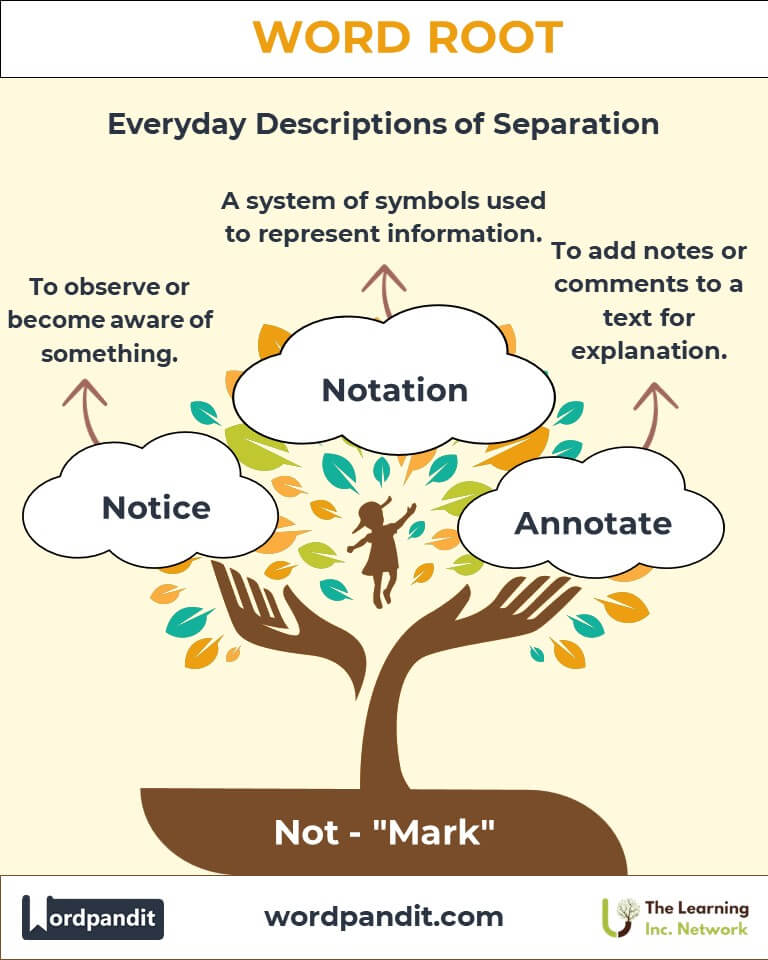Not: Marking Meaning Across Language and Expression
Discover the depth and significance of the root "not," which originates from the Latin notare, meaning "to mark." From simple words like "notice" to complex concepts like "notation," this root underscores the importance of marking, recording, and noticing in communication, arts, and sciences.

Table of Contents
- Introduction: The Mark of "Not"
- Etymology and Historical Journey
- Mnemonic: Unlocking the Power of "Not"
- Common "Not"-Related Terms
- "Not" Through Time
- "Not" in Specialized Fields
- Illustrative Story: "Not" in Action
- Cultural Significance of the "Not" Root
- The "Not" Family Tree
- FAQs about the "Not" Root
- Test Your Knowledge: "Not" Mastery Quiz
- Conclusion: The Living Legacy of "Not"
Introduction: The Mark of "Not"
The root "not" may seem unassuming, but it carries profound significance. Derived from the Latin notare, meaning "to mark," it is the foundation of words that shape how we record, notice, and interpret the world around us. Whether it’s a musical notation that guides a symphony or a public notice that informs a community, "not" stands as a testament to humanity's need to signify and communicate.

Etymology and Historical Journey
The root "not" originates from the Latin notare, meaning "to mark, observe, or take note of." In ancient Rome, scribes and scholars used notare to describe the act of marking symbols or writing down observations. Over time, the root evolved and found its way into English via Old French, enriching the language with terms that emphasize marking, recognizing, or symbolizing information.
Historical Highlights:
- In ancient Rome, "notare" was used for marking and recording important observations.
- The Renaissance era saw the widespread use of "not"-related words in music, science, and literature.
Mnemonic: Unlocking the Power of "Not"
To remember the root "not," picture a brightly colored marker circling important information in a book or creating a symbol on a page. The act of marking connects directly to the root’s essence.
Mnemonic Device: “‘Not’ marks the spot where ideas and observations are recorded.”
Common "Not"-Related Terms
- Notice
Pronunciation: no-tis
Definition: To observe or become aware of something.
Example: "She couldn’t help but notice the bright flowers in the garden." - Notation
Pronunciation: no-tay-shun
Definition: A system of symbols used to represent information, especially in music or mathematics.
Example: "The musician carefully followed the notation in the score." - Notary
Pronunciation: no-tuh-ree
Definition: An official authorized to certify documents.
Example: "We needed a notary to witness the signing of the contract." - Annotate
Pronunciation: an-uh-tate
Definition: To add notes or comments to a text or diagram for explanation or emphasis.
Example: "Students were asked to annotate the article with their thoughts." - Notorious
Pronunciation: no-tor-ee-us
Definition: Famous or well-known, often for something negative.
Example: "The outlaw became notorious for his daring heists."
"Not" Through Time
- Notary (Medieval Period): Notaries in medieval Europe were crucial for documenting legal agreements and preserving records, highlighting the root’s association with marking and certifying important matters.
- Notation (Renaissance): The development of musical notation during the Renaissance allowed composers to record and share intricate compositions, revolutionizing music.
"Not" in Specialized Fields
- Music:
Notation is vital for composing and performing music, representing rhythm, melody, and harmony.
Example: "Beethoven's symphonies are masterpieces preserved through musical notation." - Law:
Notaries authenticate legal documents, ensuring validity and preventing fraud.
Example: "A notary's seal is required for property deeds." - Literature:
Annotations enhance texts by providing context and explanations.
Example: "Shakespeare's plays often include annotations to clarify archaic terms." - Mathematics:
Symbolic notations simplify complex formulas.
Example: "Einstein’s equation, E=mc², is a powerful example of scientific notation."
Illustrative Story: "Not" in Action
In a bustling library, young researcher Clara struggled to decode an ancient manuscript. Her breakthrough came when she noticed an unfamiliar symbol repeated throughout the text. Annotating her findings, she discovered that the markings were an early form of musical notation, revealing melodies lost for centuries. Clara’s careful attention to detail highlighted the timeless importance of "not" in preserving and interpreting knowledge.
Cultural Significance of the "Not" Root
The root "not" reflects humanity’s drive to observe, mark, and communicate. From medieval notaries safeguarding trust to modern composers creating musical masterpieces, "not" is a bridge between intention and expression. Culturally, it underscores the importance of documentation, helping societies preserve their history, art, and values.

The "Not" Family Tree
- Scrib- (write):
- Describe: To write down or detail.
- Inscription: Words engraved on a surface.
- Sign- (mark):
- Signature: A person’s mark of approval or identification.
- Signify: To convey meaning.
- Graph- (write, draw):
- Graphite: Material used in pencils to mark paper.
- Autograph: A person’s own written signature.
FAQs About the "Not" Word Root
Q: What does the root "not" mean, and where does it come from?
A: The root "not" means "mark" or "observe," derived from the Latin notare. In ancient Rome, this root was central to documentation, symbol marking, and recording observations.
Q: How does "not" contribute to musical notation?
A: Musical notation is a system of symbols that represent rhythm, pitch, and dynamics. The root "not" reflects the act of marking these elements to preserve and convey music across generations.
Q: What is the role of a notary in legal contexts?
A: A notary acts as an impartial witness to authenticate documents, ensuring their legality and validity. Derived from the root "not," their work involves marking important agreements with seals or signatures.
Q: Why does "notorious" have a negative connotation?
A: "Notorious" originally derived from the idea of being widely noticed or marked. Over time, it became associated with being known for undesirable traits or infamous actions.
Q: What is the purpose of annotations in texts?
A: Annotations are explanatory notes or comments added to texts or diagrams to provide clarity, context, or emphasis. The term reflects the act of marking a text to enhance understanding.
Test Your Knowledge: "Not" Word Root Quiz
1. What does the root "not" mean?
2. Which term describes a system of symbols for music?
3. What does a notary do?
4. What is the meaning of "annotate"?
5. Which word describes being famous for something negative?
Conclusion: The Living Legacy of "Not"
The root "not" continues to leave its mark across disciplines and cultures. From ancient notaries to modern composers and mathematicians, its influence persists in the ways we record, notice, and communicate. As we embrace new tools and technologies, "not" will remain a vital part of humanity's quest to mark meaning and make sense of the world.












